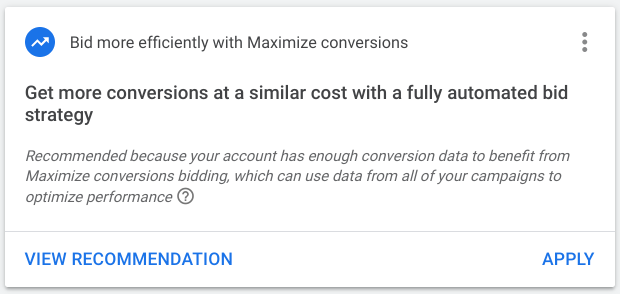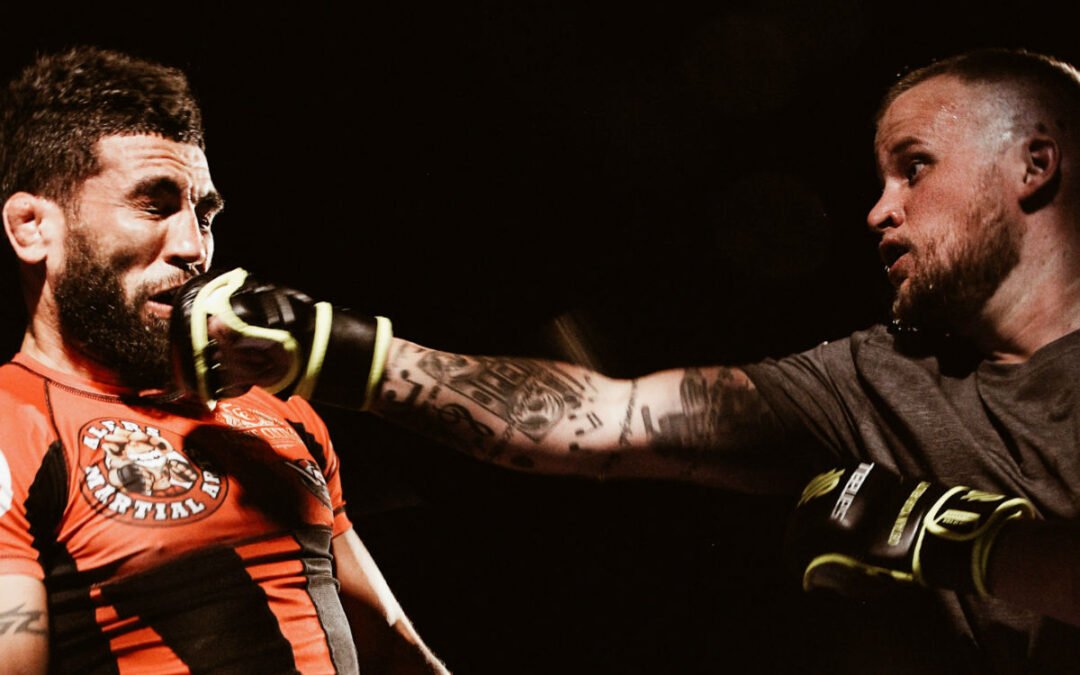Google is doing everything they can to get you to embrace automation and AI for your search engine marketing campaigns. If you are using the browser console to create campaigns, you will almost immediately be presented with the choice of bid strategies using AI (and a warning if you opt for manual CPC). If you have already set up your campaigns, you will see alerts and a lowered optimization score if you are not implementing these strategies.
- Target cost per action (CPA): Use Target CPA to help increase conversions while targeting a specific cost per acquisition/action (CPA).
- Target return on ad spend (ROAS): Use Target ROAS to help increase conversion value while targeting a specific return on ad spend (ROAS).
- Maximise Conversions: To optimise for conversions while also spending your entire budget instead of targeting a specific CPA, use Maximise Conversions.
- Maximise Conversion Value: To optimise for conversion value while also spending your entire budget instead of targeting a specific ROAS, use Maximise Conversion Value.
- Enhanced cost per click (ECPC): To automatically adjust your manual bids to try to maximise conversions, use ECPC. This is an optional feature that you can use with Manual CPC bidding.
The first two help you to target specific results (CPA or ROAS) which can limit your overall account spend. The next two are options that address this, giving you the flexibility to target a CPA or ROAS while still maximizing your budget. The fifth is Enhanced CPC, which is used as an option on manual CPC bid strategies.

Finally, if your monthly spend is high enough, you’ll likely be contacted by a Google Ads representative. They will push automation incessantly, and are in fact rewarded for each suggestion a client implements. Considering how hard Google is pushing automation, you would expect it to outperform traditional, manual CPC campaigns. Is that the case? Well, no.
Enabling Maximise Conversions on Established Campaigns
At Husaria Marketing we are constantly A/B testing to maximize the performance of our client’s PPC campaigns. This includes not only bid strategy tests, but also scripting, rules and even campaign structures like the single keyword per adgroup (SKAG) and its variants. In this example, we will be testing the performance of the Maximize Conversions bid strategy against both historical performance, and simultaneous campaigns.
Case Study Background
The client in question here is a global commercial real-estate firm, and in particular we are looking at their London campaigns.
- Campaigns are built using the single keyword per adgroup (SKAG) campaign structure, with additional negative match types.
- Campaigns are further split into device type and match type
- All campaigns share the same, thorough keyword lists. Emphasis on long-tail keywords also began around February 14th.
- Conversion attribution uses the last-click model
- The target conversion is an information request form submission, which deliver high quality leads (Goal 14).
- The industry has very high CPCs, ranging to £50+
The Maximise Conversions bid strategy has been applied to desktop users and the exact match type. Phrase and broad (BMM) match types remain manual bidding with Enhanced CPC. This means that for example [central london real estate] would be in the Maximise Conversions bid strategy, while “central london real estate” and +central +london +real +estate would remain unchanged. The dilution of match types by Google has been addressed by applying negative match types to each individual keyword/adgroup. This means that for example +central +london +real +estate would have “central london real estate” and [central london real estate] negative matched.
This test has run for 4 weeks, from February 14th to March 5th, 2020.
Maximise Conversions Test Results
In four weeks of testing, we have seen significant changes in the performance of our campaigns by switching to Maximise Conversions. It has been mostly negative.

In this view we are comparing the performance of the test campaign from February 14th to March 5th to the previous period where a manual bidding strategy with Enhanced CPC was implemented. As we can see, the resulting changes have been quite dramatic. The most notable change has been in CPC, which more than doubled. As a result, our spend has also increased. Because of the increase in CPC, we’ve seen a decrease in overall click numbers, and therefore users and sessions as well. The increase in CPC is expected, and shared with the non-AI campaigns.
On a positive note, we’ve seen a strongly improved bounce rate as well as pages per session, suggesting that the traffic coming through should be good. These results are also shared with our phrase and BMM campaigns. Unfortunately, we haven’t seen any conversions, versus 2 for the same period at nearly half the spend. But what about assisted conversions, you ask?

Assisted Conversions in Google Ads
It’s even worse. Over the test period the Maximise Conversions campaign not only didn’t record any last-click conversions, it also didn’t record any assisted conversions of any kind. Two direct conversions appear to have come through, though down from 10. Pretty brutal. What about the phrase and BMM campaigns using the same keywords over the same time period?

Enhanced CPC Performance
Finally, some good news. But this is from our manual bidding campaigns. These are the combined results for the phrase and BMM campaigns. As opposed to the slump observed in our test campaigns, performance here has improved noticeably. We see a similar increase in cost, slightly lower but still significant increase CPC, and improvements in bounce rate and pages per sessions as well. What differentiates the performance here from the test campaigns, is the actual conversion totals, which are growing, as well as the overall conversion rate, which has more than doubled.

Assisted Conversions for our Manual CPC Campaigns
Looking at our assisted conversions, there is more of a mixed bag, but still significant improvement over the test campaign’s goose egg. Compare the zero assisted conversions to the overall increase in the manual campaigns of 3 to 8.
Maximise Conversions Bid Strategy Test Results
The results are in, and they’re bad news for proponents of automation. Despite raising our budget by over 50%, we saw a complete collapse in conversions for our Maximise Conversions test campaign. Performance from our control campaigns which used the same keyword lists (though different match types) saw broad improvement over the same time range.
Why Didn’t Maximise Conversions Work?
Considering how advanced Google’s AI is, why didn’t this automated bidding strategy work? We can glean a little insights about how these strategies work by looking at the recommendation boxes that pop up for non-automated campaigns:

Bid more efficiently with AI? Maybe not.
As you can see, the top signals being used by this “artificial intelligence” are fairly straightforward. Creating ad schedules and lowering bids on under-performing keywords looks to accomplish the same thing. These are daily or weekly tasks that Google Ads managers should be engaged in anyway. Plus, with high-CPC campaigns like these, the total number of conversions is very limited. This means that a signal from a single conversion can change the strategy. A fully invested manager who understands the industry and the account could for example exclude outliers when making performance decisions.
Why Use Fully Automated Bid Strategies
Fully automated bid strategies are definitely time savers. At the same time the Maximise Conversions test was running, our control campaigns were under vigilant monitoring, with daily adjustments. The amount of time saved is significant, but who does that benefit? The agency or freelancer suddenly has more free time on their hands to pursue other tasks, but the client is losing out on performance.
That’s not to say fully automated bid strategies don’t work. Ample evidence exists that these strategies work, and Google is only increasing how hard they are pushing these solutions to PPC campaign managers. After all, Google is simply taking your existing data, and adjusting your bids to focus on those times, demographics and keywords that perform the best.
For fully automated bid strategies to work best, you need data. The more data the algorithm has to work with, the more accurate its decisions should be. However, when you’re operating on very high CPC campaigns without the necessary volume of conversion data, you may stumble. The less data you have, the more important human vigilance and intervention is required.
It doesn’t end there. These automated bidding strategies won’t set landing pages and ad copy for you, which can play a huge role in the success of your campaigns. In particular we have seen adding responsive search ads as a low-hanging fruit that quickly boosts performance.
Fully Automated Bid Strategy Conclusions

Every client is different, and your campaigns and strategies must be tailored to fit their needs and budget. That being said, over the last two years we have improvements without exception in PPC performance for clients by implementing manual bid, modified SKAG campaigns. We do regularly test fully automated bid strategies, often at the request of clients who have spoken to a Google rep that is incentivized to push them. These algorithms will only improve over time, as Google gathers data (the underlying goal for them), and we will continue to test them to make sure our clients are getting the absolute best performance for their campaigns. To date, that remains using manual bidding with Enhanced CPC and human monitoring, especially when dealing with highly-competitive and expensive keywords.

The next time you see a warning like the one above, take it with a grain of salt. Because in our experience, it’s untrue, save for Enhanced CPC which we recommend enabling in most cases. In this case, human intervention retains the belt without much challenge from AI.



